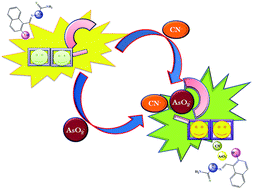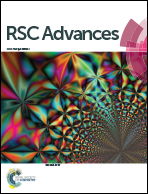Dual anion colorimetric and fluorometric sensing of arsenite and cyanide ions†
Abstract
A naphthalene appended probe, 2-((2-hydroxynaphthalen-1-yl)methylene)hydrazine carbothioamide, was synthesized and found to recognize AsO2− and CN− ions with turn-on emission fluorescence over different anions in a DMF : H2O (HEPES buffer, pH = 7.2) (9 : 1, v/v solution) medium. The probe was characterized using different techniques including NMR, IR, CHNS, UV-visible and ESI mass spectroscopy. This probe shows colorimetric change and an enhancement in the fluorescence emission with arsenite and cyanide ions among the other anions. The 1 : 1 and 1 : 2 stoichiometries of the probe with arsenite and cyanide ions, respectively, were calculated from the Job's plots based on the UV-visible spectra. The binding constant was established using the B–H (Benesi–Hildebrand) plots for both anions arsenite and cyanide as 3.1 × 105 and 1.9 × 106, respectively. The limit of detection (LOD) of arsenite and cyanide ions was 66 nM and 77 nM, respectively, using the emission spectra. The binding affinity of probe L with both anions was determined using NMR, DFT optimization, ESI-mass spectroscopy, electrochemical behavior and optical studies. The probe is the first chemical sensor that detects both major toxic anions with significantly high detection limits.


 Please wait while we load your content...
Please wait while we load your content...